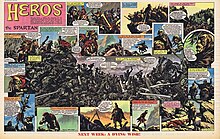
Heros The Spartan appeared in Eagle from 1962 to 1966 and was created by Ken Mennell [1] but was written solely by Tom Tully. It seems reasonable to assume that the film Spartacus (1960) inspired some of the story's creation. The comic strip began as a double-page centrespread colour strip and told the adventures of a Spartan, discovered as a child by the Roman commander Arcus and then adopted by him. On the death of his Roman father, Caesar sends for Heros. The Emperor explains that to become a legion commander he must prove himself by sailing to the ‘Island of Darkness’. From there the stories return to Rome and Caesar's treachery becomes apparent in the impossible tasks he sets. The 'sword and sorcery' stories take place in the Roman Empire but with many fantasy elements.
The remainder of the "Heros" stories were illustrated by Luis Bermejo in the comic and the Annuals, although in an interview Eric Kincaid tells of how he was asked to produce an episode in Bellamy's run but Bellamy hit the deadline and Kincaid's was never published. [2]

Some artwork by Bellamy and Bermejo was used by Al Williamson in his Creepy #6 story "Thumbs Up". [3] and Barry Windsor-Smith also was inspired by Bellamy's work on "Heros". [4]
A reprint of Frank Bellamy's run on "Heros" was published in two formats in 2013. [5]